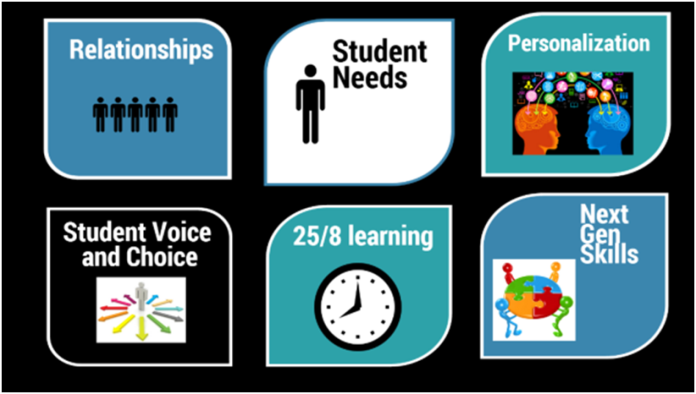In today’s society, all K-12 learning environments should currently be using blended learning—incorporating a learning management system (LMS) in conjunction with traditional brick and mortar, face-to-face instruction to enhance learning.
Students attending schools with hybrid models attend class part of the time, and learn online part of the time. A hybrid model allows a student to remain in their “school” with their neighbors, friends, etc. and avoid having to attend a charter school in order to find this flexibility, personalization, voice and choice.
Schools implementing a hybrid model usually:
- use an LMS to afford students flexibility in path, pace, place and time
- seek best practices for personalizing learning for students

Benefits of Hybrid Learning
Using itslearning, Forsyth County School System (near Atlanta, Georgia) was able to start the first public school hybrid model in the southeast United States: traditional students in a brick and mortar school were offered the flexibility to personalize their learning while working remotely on Mondays and Fridays (under certain guidelines and parameters).

The seamless use of itslearning allowed teachers to develop their content modules, incorporate video clips, and include remediation and enrichment.
Additionally, the student planner—one of my personal favorite parts of itslearning—allows students, parents, teachers, administrators and counselors to constantly see what is going on academically in the life of a student (even when they are absent). Organization is one of the skills that students have a hard time mastering, yet itslearning makes it easy for them, while making it easy to communicate with parents.
With students working remotely two days a week, our teachers needed a reliable learning management system with effective communication tools, assessment tools and remediation/enrichment tools. Without any one of these, our work with students—and in providing students flexibility and personalization strategies—would not have been possible. Our ability to dream and envision these possibilities would not have been imaginable.
I have had the opportunity to work with various learning management systems, both free and purchased, and I have to say that I am a huge advocate of itslearning. Its usability and intuitiveness made it easy to move forward with innovative instructional practices that were best for students!
Below is a list of hybrid learning benefits that I've compiled.
For Students
Personalization
Effectiveness and socialization opportunities of the classroom with the self-directed and active learning opportunities that the online environment offers (Dzuiban, et al, 2004) allowing educational leaders to move education to more personalized learning (student-driven) rather than differentiated learning (which is still teacher-driven).
Flexibility
Flexibility to move on when ready and convenient for those students who participate in community and extra-curricular activities. It allows students the flexibility (two days of the school week) to move at their own path, place, pace and time. (Horn and Staker).
Next Gen Learner Skills
Develop skills that are not always possible in the traditional face-to-face, brick-and-mortar setting. Digital citizenship, information skills, self-directed learning, web research skills, web 2.0 collaborations, creativity, innovation, problem-solving and critical-thinking skills. Ultimately, students will have more voice and choice in showing mastery of content.
True School Experience
Hosting a Hybrid Model within your school allows students to stay involved at ‘their’ school making connections athletically, socially, and via extra-curricular activities with those students in ‘their’ community – students they see live, work, play, shop, etc.
Learner Motivation
Universal catalysts for motivation include curiosity, choice, agency, and self-efficacy whether in an academic environment, creating art, or performing athletically. A hybrid learning classroom where students can access both instruction and content in the classroom and online is no different in that respect; a student’s ability to follow their curiosity, recognize and evaluate possible learning pathways, collaborate freely, and interact directly with content and peer sets all impact the confidence, curiosity and motivation of a learner. Additionally, the ability to self-monitor and adjust cognitive ambition, potential modes, and the relative quality of their own thinking and performance are each factors in student motivation (Heick, 2013).
For Teachers, Administrators, and Districts
Instructional Strategies
Teachers use varied instructional strategies through an LMS to meet more needs of learners and learner styles.
Teacher-Student Ratio for Remediation
Students who are making below 75% lose the privilege of working autonomously/remotely and receive the opportunity to work with teachers on Mondays and Tuesdays when others are at home.
Recruit and Retain
Administrators have the ability to offer teachers flexibility in scheduling, like in other professions. (i.e. working remotely).
Facilities Management
Offers administrators a chance to vary how facilities are used.
No Instructional Lapse
Models like this allow for instruction to always be available and to best meet student needs. (inclement weather, etc.)
Innovative Practices
Evidence-based practices designed to facilitate a personalized climate in the school.
Funding
Students stay at their home school because of the innovative program, rather than selecting an alternative program. Funding stays at home school.